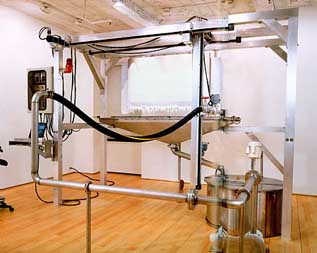
|
||
|
Portland art blog + news + exhibition reviews + galleries + contemporary northwest art
|
||
Roxy Paine's PMU
Function finds little room in contemporary art, a realm where dysfunction, tension and absurdity operate best. While Roxy Paine's automatic art-making machine—the Painting Manufacture Unit, or PMU on view through Sunday at the Portland Art Museum—could easily fall prey to the cynicism inherent the task of automating the creative process, its functionality saves it from merely becoming an exercise in pure critique. Paine's PMU is part of a series of flawlessly-built art-making machines that include a Drawing Machine, several SCUMAK (Auto Sculpture) machines and an Erosion Machine. Constructed with an industrial scale and durability, the PMU is built to produce unique, vaguely Abstract Expressionistic canvases. At regular intervals, a red warning light flashes, signaling the start of each painting cycle. A large robotic arm spews white paint in a neatly choreographed trajectory from left to right towards a canvas dangling from the center of a large network of stainless steel frames, tubes and vats. Each layer is allowed a long drying period before the cycle begins again. The finished paintings, which take dozens of cycles and approximately 3 weeks to complete, are completely bare at the top, revealing raw brown canvas. Thickly layered stratas of white paint build up at the bottom of the canvas, forming thick, sculptural mounds of paint that hang off of the surface like stalactites, reminiscent of Paine's other body of work consisting of hyper-realistic sculptures of natural forms. Paine's PMU is part of a lineage of art-generating machines that date back at least as far as Jean Tinguely's mid-century contraptions. But most are premised on an underlying skepticism of machines or a strong critique of the politics of the art market. Rebecca Horn's kinetic painting machine, entitled "the Little Painting School Performs a Waterfall," is in essence a logical step from her wearable forms and performances, using purely mechanical elements to mimic painterly action. The machine is crude and functions as an inadequate surrogate for nature and the human action of painting rather than as a machine for production. The lesser known drawing machine of British artist Harold Cohen, which dates back to the early 1980s, is based on similar, if more scientific and statistical, attempts to capture artistic gesture, using a combination of artificial intelligence, sophisticated software and customized hardware. Wim Delvoye's recent Cloaca, which is most similar to Paine's PMU in terms of its flawless, industrial-grade construction, does not produce traditional art forms, but instead employs a complex network of mechanics and chemicals to mimic human digestion. The scatological output of this process is sealed, packaged and sold as art. While there is some degree of absurdity in the very notion of creating an automatic painting machine, Paine's machine differentiates itself because it not only delivers a thrilling performance, but a surprisingly convincing end product. While the tongue-in-cheek nature of his work cannot be missed (Paine even includes an ashtray and beer holder for the imaginary machine operator that is conspicuously absent), Paine carefully sidesteps clear answers to the line of questioning that his painting machine prompts. One can certainly find human-esque behavior in everything from the periodic pauses the machine makes in between "strokes" to the mock-gestural qualities of the paint. But Paine has not created this machine simply to imperfectly mimic human actions nor has he created a machine that obliterates the need for human creation. Paine obviously mocks the masculine gesture of Abstract Expressionism, but the resulting pieces seem less critical than seductive and fashionable. Paine points the way towards a line of questioning about the creative act, market value, and mass production, but at the same time goes to great lengths to improve both his process and his machines. Paine may leave the door open for the viewer to pursue a critique of the art world, but perhaps more importantly engages an uncritical fascination with mechanics and the very nature of the basic processes of creation itself. Through Sunday, May 28th Posted by Katherine Bovee on May 27, 2006 at 22:45 | Comments (2) Comments I can't help but consistently think of wonderful artists such as Thomas Kinkade when I view this piece. Man, I tell you, if there is ever a contest for the best painter in the history of man, the "Painter of Light" will crush all opposition! Posted by: Calvin Carl I consider PMU his most important work and you can see how its construction lead him to the stainless steel trees. One thing that I liked about chatting with Paine was his emphasis on machine time as compared to human time and geological time. It has none of the menace of Tinguely's work (early modernism wasn't always hopeful about machines and their effect upon our lives) and I like how it conflates a literal take on Warhol's POP factory with the abstract expressionsists while churning out geological features. The machine is hilarious to boot. Paine is essentialy an artist interested in the confluence of time and material as mediated both by the viewer and the artist's expectations. With this machine both the viewer and artist get to view the creation of paintings at the same time, breaking down the studio barrier. Still the creation of the machine that created the paintngs was a more private affair between Roxy and his materials (and research). Posted by: Double J Post a comment Thanks for signing in, . Now you can comment. (sign out)
(If you haven't left a comment here before, you may need to be approved by
the site owner before your comment will appear. Until then, it won't appear
on the entry. Thanks for waiting.)
|
| s p o n s o r s |
 |
 |
 |
 |
 |
 |
 |
 |
 |
 |
 |
 |
 |
 |

|
Site Design: Jennifer Armbrust | • | Site Development: Philippe Blanc & Katherine Bovee | |



![[TypeKey Profile Page]](http://www.portlandart.net/nav-commenters.gif)